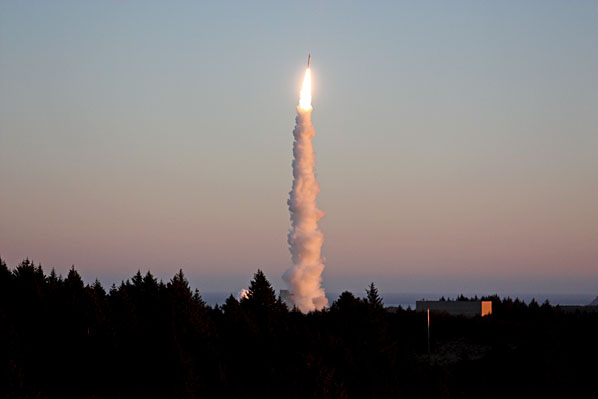博文
FASTRAC任务发射入轨,微腔放电推进器将首次实际应用
|||
http://fastrac.ae.utexas.edu/news/recent.php
http://fastrac.ae.utexas.edu/for_radio_operators/overview.php
http://www.spaceflightnow.com/minotaur/stps26/status.html
FASTRAC(带有推力、相对导航和姿态控制的编队自主飞行)任务 Is In Orbit!
November 20, 2010

FASTRAC was launched into orbit on Friday November 19 at 7:21 pm Central Standard Time! It was successfully inserted by a Minotaur IV rocket into a 650 km altitude, 72 degree inclination orbit. FASTRAC has been transmitting beacon and crosslink data which have been received by amateur radio operators around the world.
Control of the satellite was transferred to The University of Texas at Austin shortly after launch vehicle separation at 7:56 pm. The first known FASTRAC beacon received from space was reported by DK3WN in Germany at 12:01 am (CST) November 20. The two FASTRAC satellites, Emma and Sara Lily, were both heard transmitting to ground and crosslinking with each other. Since then, radio contacts have been reported by amateur radio operators around the world.
The University of Texas at Austin Ground Station heard the FASTRAC beacon in its first pass over Austin at 6:22 am. The station plans to verify the command link at the earliest opportunity. Once this occurs, the mission will enter its initial subsystem checkout phase. All satellite systems appear to be functioning as planned based on first look data.
The FASTRAC mission is divided into two basic phases.
The first phase is the science portion of the mission. During this phase the two satellites will be sharing GPS data as long as they are within range of each other. The GPS data will be processed on board each satellite and then stored in flash memory to calculate an on-orbit relative navigation solution. Also, the satellites will be performing attitude determination with the GPS receiver. FASTRAC 1 will be firing the micro-discharge plasma thruster whenever the thrust vector is within 15 degrees of the anti-velocity vector. The data will be relayed to the ground when the satellite is in communication with a ground station. A coordination plan is being developed so that participating amateur radio ground stations can play a major role in collecting this data and relaying it back to this Web site.
The second phase of the mission begins by reconfiguring the satellites for use by the amateur radio community. The satellites will be reconfigured so that they can be used as digipeaters and form part of the Automatic Position Reporting System (APRS) network. The capabilities of these satellites are governed largely by the functionality of the Kantronics KPC9612-Plus TNC. The satellites will be reconfigured after the primary mission to serve on the APRS network.
https://wap.sciencenet.cn/blog-80228-400663.html
上一篇:第三十届国际电离气体现象会议征文
下一篇:电推进的分类-回答河北省蠡县中学同学问题!
全部作者的其他最新博文
全部精选博文导读
相关博文
- • 聚英才 建高地 | 北京理工大学“特立青年学者”全球招聘开启
- • 700年后日本或濒临灭绝?日本学者推算预测:届时或仅剩1名15岁以下孩子
- • [转载]【同位素视角】非英语母语学者如何区分’e.g.’, ‘i.e.’, ‘namely’与‘such as’等混淆难题
- • 美国佐治亚大学等机构学者:刈割策略对Bulldog 805紫花苜蓿+Tifton 85狗牙根混播草地产量及品质的影响
- • 美国堪萨斯州立大学、密苏里大学等机构学者研究成果:土壤水分管理策略和品种多样性对紫花苜蓿产量、营养品质和农场盈利能力的影
- • 德国、捷克草业科学学者长期放牧实验:异质草地斑块中的土壤有机碳储量和地下生物量